

Print Article. Written by the founders of Food Tank; 13 resolutions for changing the food production system.
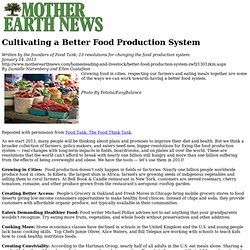
Reposted with permission from Food Tank: The Food Think Tank. As we start 2013, many people will be thinking about plans and promises to improve their diet and health. But we think a broader collection of farmers, policy-makers, and eaters need new, bigger resolutions for fixing the food production system — real changes with long-term impacts in fields, boardrooms, and on plates all over the world. These are resolutions that the world can’t afford to break with nearly one billion still hungry and more than one billion suffering from the effects of being overweight and obese. We have the tools — let’s use them in 2013! Redundant trade threatens environment and food ... A rural sociologist and researcher for the National Farmers Union (NFU) says redundant global trade is not only contributing to global greenhouse gas emissions but is also threatening local economies and the livelihood of farmers.
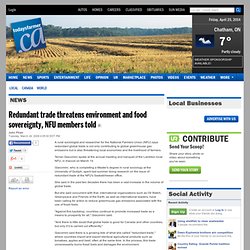
Terran Giacomini spoke at the annual meeting and banquet of the Lambton local NFU, in Inwood on March 14. Giacomini, who is completing a Master's degree in rural sociology at the University of Guelph, spent last summer doing research on the issue of redundant trade at the NFU's Saskatchewan office. She said in the past two decades there has been a vast increase in the volume of global trade. chd.region.waterloo.on.ca/en/researchResourcesPublications/resources/Redundant_Trade.pdf.
Home - Trade Data Online. What is the province of origin?
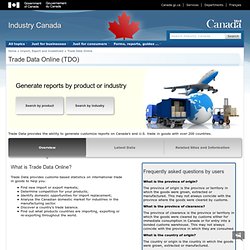
The province of origin is the province or territory in which the goods were grown, extracted or manufactured. This may not always coincide with the province where the goods were cleared by customs. What is the province of clearance? The province of clearance is the province or territory in which the goods were cleared by customs either for immediate consumption in Canada or for entry into a bonded customs warehouse.
This may not always coincide with the province in which they are consumed. What is the country of origin? The country or origin is the country in which the goods were grown, extracted or manufactured. What is the country of destination? The country of destination is the country which is the last known destination of the goods at the time of export. ... more. Community Food Atlas - Community Food Atlas. foodsecurecanada.org/sites/default/files/Provincal_approaches_to_FS_policy_scan.pdf. statistics.smartfarmbc.ca/sites/statistics.smartfarmbc.ca/themes/bc/export_profiles/bc_export_apples.pdf.
Vancouver's living wage hits $18 an hour - British Columbia. Working people in Metro Vancouver need to earn more than $18 an hour in order to meet the most basic costs of raising a family, a new report says.
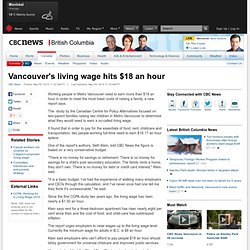
The study by the Canadian Centre for Policy Alternatives focused on two-parent families raising two children in Metro Vancouver to determine what they would need to earn a so-called living wage. It found that in order to pay for the essentials of food, rent, childcare and transportation, two people working full-time need to earn $18.17 an hour apiece. One of the report's authors, Seth Klein, told CBC News the figure is based on a very conservative budget.
Average hourly wages of employees by selected characteristics and occupation, unadjusted data, by province (monthly) (British Columbia) 2001 Census of Agriculture - Profile of British Columbia's farm operators. All releases > Profiles of Canadian farm operators > Distribution of farm operators in British Columbia by age class, 1991 to 2001 Other highlights The number of farm operators in British Columbia declined 8.0%, from 32,950 in 1996 to 30,320 in 2001.
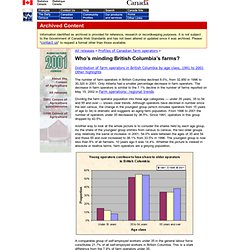
Only Alberta had a smaller percentage decrease in farm operators. The decrease in farm operators is similar to the 7.1% decline in the number of farms reported on May 15, 2002 in Farm operations: regional trends. Dividing the farm operator population into three age categories — under 35 years, 35 to 54 and 55 and over — shows clear trends. Another way to look at the whole picture is to consider the shares held by each age group. www.statcan.gc.ca/pub/16-201-x/16-201-x2009000-eng.pdf. A Snapshot of the Canadian Vegetable Industry, 2010 - Agriculture and Agri-Food Canada (AAFC)
Alternative Formats Note: Some of the content is wider than usual.
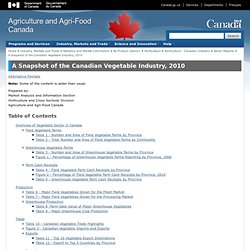
Prepared by:Market Analysis and Information SectionHorticulture and Cross Sectoral DivisionAgriculture and Agri-Food Canada Overview Of Vegetable Sector In Canada The Canadian horticultural sector includes field-grown vegetables, potatoes, greenhouse vegetables, fruits, ornamental products (floriculture, nursery, Christmas trees, and sod), honey, maple products, ginseng and herbs and spices. Due to the scope of this report, the areas of focus will be limited to fresh, processed and greenhouse vegetables. There were 9,499 vegetable farms in Canada in 2006, representing 4% of total farms. Ontario also ranked first in terms of the physical area where vegetables are grown with 62,967 hectares, down 9% compared to its share in 2001. Field Vegetable Farms Sweet corn area declined by 15% in 2006 when compared to 2001 even though it occupied 24% of all vegetable area. Greenhouse Vegetable Farms Farm Cash Receipts. The growing problem: Canada slips from agricultural superpower status.
Canadians like to think of this country as an agricultural superpower, where farmers grow vast amounts of food to help feed a hungry planet.
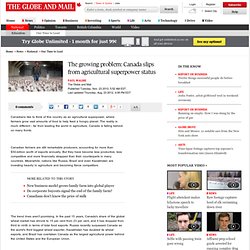
The reality is much different - far from leading the world in agriculture, Canada is falling behind on many fronts. Canadian farmers are still remarkable producers, accounting for more than $30-billion worth of exports annually. www.gov.bc.ca/agri/down/bc_agrifoods_strategy.pdf. www.bcbc.com/content/580/2020_201004_AgriFood.pdf.
2011-2012 Agriculture and Agri-Food Market Access Report - Agriculture and Agri-Food Canada (AAFC) Re-opening, Maintaining and Expanding Markets Alternative Formats Ministers' Message The Government of Canada is undertaking the most ambitious trade expansion plan in Canadian history.
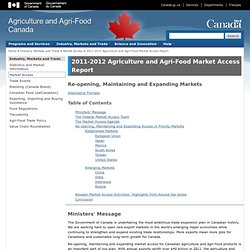
We are working hard to open new export markets in the world's emerging major economies while continuing to strengthen and expand existing trade relationships. More exports mean more jobs for Canadians and sustainable long-term growth for Canada. Get Local. Human Activity and the Environment: Annual Statistics: Section 1: Food in Canada. Photo Introduction Food is much more than a commodity to be bought and sold.
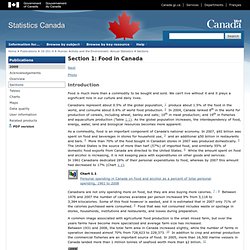
We can't live without it and it plays a significant role in our culture and daily lives. Canadians represent about 0.5% of the global population, 1 produce about 1.5% of the food in the world, and consume about 0.6% of world food production. 2 In 2004, Canada ranked 8th in the world for production of cereals, including wheat, barley and oats; 10th in meat production; and 19th in fisheries and aquaculture production (Table 1.1).
As the global population increases, the interdependency of food, energy, water, land and biological resources becomes more apparent. Designers and Food Experts Create Infographics on Beef, New Farms. Monday, Food+Tech Connect announced the winners of the Farm Bill Hackathon.

But several other interesting projects were also created at the event, held December 3, 2011 in NYC. A final virtual project from the day will also be featured tomorrow. Consolidation of the Meat Industry An illuminating graphic on beef production and industry consolidation was created by Alexandra Tung, Chris Hunt, Nika Stelman, James Boo, Kate Schmidt, Brielle Maxwell, Nichelle Stephens and DD Maucher.
The group was interested in visualizing where each penny of a consumer dollar goes. aitc.ca/bc/uploads/resources/AAF%20FARMGUIDE%202008.pdf. foodsecurecanada.org/sites/foodsecurecanada.org/files/FSC-resetting2012-8half11-lowres-EN.pdf. Why Diet Matters. Wasted Opportunity. Changing the Global Food Narrative. USC Canada » The Food System. Back Down to Earth! The Big Picture In many countries of the global South, the best agricultural land is used to grow crops destined for export markets.
These are often luxuries or inedible crops like cotton, tobacco, coffee, sugar, cacao for chocolate, or hops for beer. Local communities often have little choice but to grow their own food on marginal lands and, despite their skill and knowledge, don’t always have enough to eat. Farm workers who grow export crops find their income dependent on prices that shift drastically based on economic changes half a world away. Around the world, farmers and their communities are questioning a global system of industrialized farming.
The Local Picture When a community has Food Sovereignty, the farmers and other residents control what and how food is produced and consumed. Hungry for More? What Product Categories Generate Most Volume In A Grocery Store? ALR Mapping - Fraser Valley Regional District. www.fnhc.ca/pdf/Traditional_Food_Facts_Sheets.pdf. Protecting the Agriculture Land Reserve. UPDATE: On March 27, the BC Government introduced Bill 24 to divide the ALR into 2 zones, with the aim of opening “Zone 2″ in the North and Interior of BC to non-agricultural development. Our analysis of the Bill has been sent to all MLAs and officials in local governments. You can view the cover letter here and the full Bill 24 breakdown here. See the BCFSN April 3 New Release responding to the Local Food Act here and the full text of the Act here.
See the BCFSN March 29 Media Release responding to Bill 24 here and our media backgrounder here. www.biodiversitybc.org/assets/Default/BBC_Biodiversity_Atlas.pdf. British Columbia. British Columbia is Canada's most westerly province, and is a mountainous area whose population is mainly clustered in its southwestern corner. BC is Canada’s third-largest province after Québec and Ontario, making up 10 per cent of Canada’s land surface. British Columbia is Canada's most westerly province, and is a mountainous area whose population is mainly clustered in its southwestern corner. BC is Canada’s third-largest province after Québec and Ontario, making up 10 per cent of Canada’s land surface. British Columbia is a land of diversity and contrast within small areas. Coastal landscapes, characterized by high, snow-covered mountains rising above narrow fjords and inlets, contrast with the broad forested upland of the central interior and the plains of the northeast.
Land and Resources Regions British Columbia has two main regions, often called "the Coast" and "the Interior. " www.geog.uvic.ca/wellness/Women/WS4_FoodSecurity.pdf. www.al.gov.bc.ca/organics/organics_industry/section3.pdf. www.agf.gov.bc.ca/stats/Export/2011BCAgrifoodsExportHighlights.pdf. www.policyalternatives.ca/sites/default/files/uploads/publications/BC%20Office/2010/11/ccpa_bc_every_bite_counts_full.pdf. www.metrovancouver.org/planning/development/agriculture/AgricultureDocs/AgricultureBackgrounderMarch09.pdf. www.gov.mb.ca/agriculture/statistics/food/canada_consumer_report_en. www.dietitians.ca/Downloadable-Content/Public/BC_CostofEating_2009-(1).aspx. In BC's Heartland, Healthy Food Can Be Scarce. 'Food deserts' blight some rural areas of the province. How to make them bloom with nutrition?
Once a breadbasket, Bella Coola hosts a Community Supported Agriculture project. It's a good day in Dease Lake when a produce truck breaks down on the Cassiar highway. For residents in and around this remote northern community, fresh produce can be hard to come by, especially in the winter. So when there's an accident, word goes out and people salvage what they can from the trailer before everything rots, according to Christine Glennie-Visser, regional co-ordinator for the Healthy Eating and Active Living (HEAL) network in northern B.C.
"These are average, regular people," she says. Even amidst scary reports about the cost of skyrocketing food prices and looming shortages, it's hard for most North Americans to fathom what it would be like to find supermarket shelves bare. How to nourish Vancouver’s surprising food deserts. People marooned in B.C.’s wealthiest neighbourhoods have the least access to fresh foods and fresh food retailers, according to a study by University of British Columbia researcher Jennifer Black. “It turned out to be the opposite of what we expected,” said Black. Higher income neighbourhoods in B.C.’s urban centres tend to have fewer food stores, she found. That means people in the city’s least dense neighbourhoods who are aging and less mobile or living in basement suites have less access to healthy foods, Black said. Conventional wisdom has it that the city’s least well-off are most likely to lack access to fresh foods, a misconception fuelled by studies from the United States that found “food deserts” in urban Afro-America and Hispanic neighbourhoods.
But Black and her colleagues Richard Carpiano, Stuart Fleming and Nathanael Lauster found that in B.C., the opposite may be true. “I wondered if it was the case here, especially considering the progressive food community here,” she said. Greater Vancouver Food Bank Society. www.phsa.ca/NR/rdonlyres/A359DCB6-2D22-46F7-A0FD-57C4FA8C25E7/0/CommunityFoodSystemAssessmentACompanionToolfortheGuide.pdf. Farm Folk City Folk. Exports and Imports - Data - BC Stats. www.metrovancouver.org/planning/development/AgricultureAndFood/Documents/RegionalFoodSystemStrategy.pdf. Feeding Frenzy. BC Agriculture in the Classroom - General Resources. Schools that are part of the BC SFVNP receive a hard copy of this booklet filled with the Scoops and Double Scoops. Food Security+Food. www.iisd.org/pdf/agrifood.pdf.
www.capi-icpa.ca/pdfs/2012/CAPI_Beef-Food-System_2012.pdf. lifecyclesproject.ca/resources/downloads/Where_in_the_world.pdf. Water Use+Agriculture. Brook Harker,1 John Lebedin,1 Michael J. Goss,2 Chandra Madramootoo,3 Denise Neilsen,4 Brent Paterson5 and Ted van der Gulik6 1 Agriculture and Agri-Food Canada, Prairie Farm Rehabilitation Administration, Regina, SK2 University of Guelph, Chair of Land Stewardship, Guelph, ON3 McGill University, Department of Agricultural and Biosystems Engineering, Montreal, QC4 Agriculture and Agri-Food Canada, Pacific Agri-Food Research Centre, Summerland, BC5 Alberta Agriculture, Food and Rural Development; Irrigation Branch, Lethbridge, AB6 B.C. Ministry of Agriculture, Food and Fisheries; Resource Management, Abbotsford, BC Current Status Land and Water Use Agriculture accounts for 3% of Canada’s gross domestic product, making it one of the largest sectors in the country.
Although agriculture is not Canada’s largest user of water, it is the largest net consumer. Impacts of Farming on the Hydrologic Cycle Effects of crop type on runoff and sediment loss are well known (Table 2). Drainage Effects. Food Demand Trends. Fast STATS Ca. CA Eating Habits. Consumer Behaviour. Beverage Consumption. Industry Structure. What We Produce and What We Consume. Human Activity and the Environment: Annual Statistics: Section 1: Food in Canada.
Energy Use. New Plan for Food. Farmers' markets and local food systems. Alexandra Link and Chris LingPublished June 18, 2007 Case Summary There is a movement towards strengthening the local food system on Vancouver Island. This case study addresses a key component of the local food system: food distribution by local agricultural producers. In particular, it concentrates on farmers’ markets, an important aspect of food distribution. Given the links between local food systems and sustainability and the desired role of farmers’ markets in local food systems, studying farmers’ markets can offer insights into the barriers and opportunities that exist for strengthening local food systems and achieving sustainability outcomes. The study considers the creation of a farmers' market in the Royal Oak area of Saanich, BC. Sustainable Development Characteristics Farmers’ markets, through their potential to sustain and support the local food system, can contribute to sustainability goals.
Vancouver Local Food.